Experimental Investigation of the Deformed Stagger-Jointed Segmental Tunnel Linings Strengthened by Epoxy-Bonded Filament Wound Profiles
Abstract
1. Introduction
2. Filament Wound Profiles
3. Full-scale Experiment
3.1. Experimental Program
3.1.1. Strengthening Method
3.1.2. Experimental Specimen
3.1.3. Loading Scheme
3.1.4. Measurement Program
3.2. Failure State
3.2.1. Structural Failure
3.2.2. Bond Failure
3.3. Experimental Results
3.3.1. Structural Deformation
3.3.2. Material Strain
3.3.3. Relative Slip and Stripping Value of the Bond
4. Discussion
4.1. Internal Force of Filament Wound Profiles
4.1.1. Assumption
- (1)
- Interfacial bonding assumption: The concrete segments and the FWPs are perfectly bonded to form composite linings that bear the external load. When P1 > 800 kN, the bond at 0° between the FWPs and the segments failed, and the strengthened linings at 0° was locally changed from a superimposed structure to a composite structure. With the same boundary and load conditions, the internal force of the composite structure is smaller than that of the superimposed structure [13]. When the calculation is based on a perfect bond, the results is larger than the true internal force of the segments and the FWPs, which is a conservative design.
- (2)
- Material assumptions: The steel conforms to the elastic–plastic assumption, with an elastic modulus of 210 GPa, a yield strength of 420 MPa and an ultimate elongation of 1%. The CFRP is an ideal elastic-plastic material when it is under tension, whose elastic modulus is 235 GPa and ultimate elongation is 1%. The CFRP along the steel tube circumferential direction is not considered, and only the CFRP along the direction of the steel tubes is considered. The concrete is only considered as an elastic–plastic material when it is under compression, whose elastic modulus is 34.5 GPa and ultimate strain is 0.33%.
- (1)
- Plane section assumption: With an incremental load, all of the materials work together while the strain conforms to the assumption of a plane section.
4.1.2. Calculation Results and Analysis
4.2. Failure Process of Strengthened Segmental Tunnel Linings
4.2.1. Failure Chain
4.2.2. Weak Sections
4.3. Strengthening Benefits
5. Conclusions
- (1)
- The FWPs bear the axial force and the bending moment with incremental loads. The FWPs are under tension and a bending state at 0° and 22.5°, while they under in compression and a bending state at 56.25°, 90° and 270°.
- (2)
- Based on the experimental phenomena and the theoretical analysis, the weak sections of the FWP-strengthened linings are summarized. After strengthening, the bond between the crown and the bottom of the lining is prone to bond failure, the extrados concrete of the joint near the crown and the bottom is prone to be crushed, and the steel bars at the intrados of the crown and the bottom and extrados of the waist are prone to yielding.
- (3)
- The stiffness and ultimate bearing capacity of the structure improved significantly with the FWPs. The increase in the ultimate bearing capacity of the stagger-jointed segmental tunnel lining that was strengthening by the FWPs was 122.5 kN, and the relative increase was 18.08%. The overall stiffness of the strengthening structure was 4.11 KN/mm, and the relative increase of stiffness was 20.55.
Author Contributions
Funding
Institutional Review Board Statement
Informed Consent Statement
Data Availability Statement
Conflicts of Interest
References
- Yuan, Y.; Jiang, X.; Liu, X. Predictive maintenance of shield tunnels. Tunn. Undergr. Sp. Technol. 2013, 38, 69–86. [Google Scholar] [CrossRef]
- Ai, Q.; Yuan, Y.; Shen, S.; Wang, H.; Huang, X. Investigation on inspection scheduling for the maintenance of tunnel with different degradation modes. Tunn. Undergr. Sp. Technol. 2020, 106, 103589. [Google Scholar] [CrossRef]
- Ai, Q.; Yuan, Y. Rapid Acquisition and Identification of Structural Defects of Metro Tunnel. Sensors 2019, 19, 4278. [Google Scholar] [CrossRef] [PubMed]
- Liu, X.; Zhang, C.; Zhang, C.; Jiang, Z.J. Experimental study on the longitudinal joint in shield tunnel reinforced with FRP material. J. Railw. Sci. Eng. 2016, 13, 316–324. [Google Scholar]
- Liu, X.; Jiang, Z.; Yuan, Y.; Mang, H.A. Experimental investigation of the ultimate bearing capacity of deformed segmental tunnel linings strengthened by epoxy-bonded steel plates. Struct. Infrastruct. Eng. 2018, 14, 685–700. [Google Scholar] [CrossRef]
- Ren, T.; Liu, S.; Liu, X. Experimental study of bearing capacity of shield tunnel lining segment strengthened by corrugated steel. Tunn. Constr. 2019, 39, 317–323. [Google Scholar]
- Zhang, J.; Liu, X.; Ren, T.; Yuan, Y.; Mang, H.A. Structural behavior of reinforced concrete segments of tunnel linings strengthened by a steel-concrete composite. Compos. Part B Eng. 2019, 178, 107444. [Google Scholar] [CrossRef]
- Liu, X.; Zhang, J.; Jiang, Z.; Liu, Z.; Xu, P.; Li, Z. Experimental investigation of a segmental tunnel ring strengthened by using UHPC. China J. Highw. Transp. 2021, 34, 181–190. [Google Scholar]
- Burgess, N.; Fagents, J.; Paterson, J. Northern Line tunnel reconstruction at Old Street. Proc. Inst. Civ. Eng. 2002, 1, 1–11. [Google Scholar]
- Kiriyama, K.; Kakizaki, M.; Takabayash, T.; Hirosawa, N.; Takeuchi, T.; Hajohta, H.; Yano, Y.; Imafuku, K. Structure and Construction Examples of Tunnel Reinforcement Method Using Thin Steel Panels. Nippon. Steel Tech. Rep. 2001, 92, 45–50. [Google Scholar]
- Zhang, D.; Zhang, D. Rehabilitation of Overdeformed Metro Tunnel in Shanghai by Multiple Repair Measures. J. Geotech. Geoenviron. Eng. 2019, 145, 2019. [Google Scholar] [CrossRef]
- Chang, C.; Wang, M.; Chang, C.; Sun, C.W. Repair of displaced shield tunnel of the Taipei rapid transit system. Tunn. Undergr. Sp. Technol. 2001, 16, 167–173. [Google Scholar] [CrossRef]
- Liu, X.; Jiang, Z.; Zhang, L. Experimental investigation of the ultimate bearing capacity of deformed segmental tunnel linings strengthened by epoxy-bonded filament wound profiles. Struct. Infrastruct. Eng. 2017, 13, 1268–1283. [Google Scholar] [CrossRef]
- Wang, Q.; Shao, Y. Compressive performances of concrete filled Square CFRP-Steel Tubes (S-CFRP-CFST). Steel Compos. Struct. 2014, 16, 455–480. [Google Scholar] [CrossRef]
- Deng, S.; Shen, Z.; Liu, X.; Xu, W.; Cao, W.B.; Zhang, L.; Liu, X.Y. Experimental study on the mechanical performance of metro shield tunnel filament wound profiles. Urban Mass Transit. 2022, 6, 31–34. [Google Scholar]
- Blom, C.B.M. Design philosophy of concrete linings for tunnels in soft soils. Ph.D. Thesis, Delft University of Technology, Delft, The Netherlands, 2002. [Google Scholar]
- Yan, Q.; Yao, C.; Yang, Y.-B.; He, C.; Geng, P. An Improved Numerical Model of Shield Tunnel with Double Lining and Its Applications. Adv. Mater. Sci. Eng. 2015, 2015, 1–15. [Google Scholar] [CrossRef]

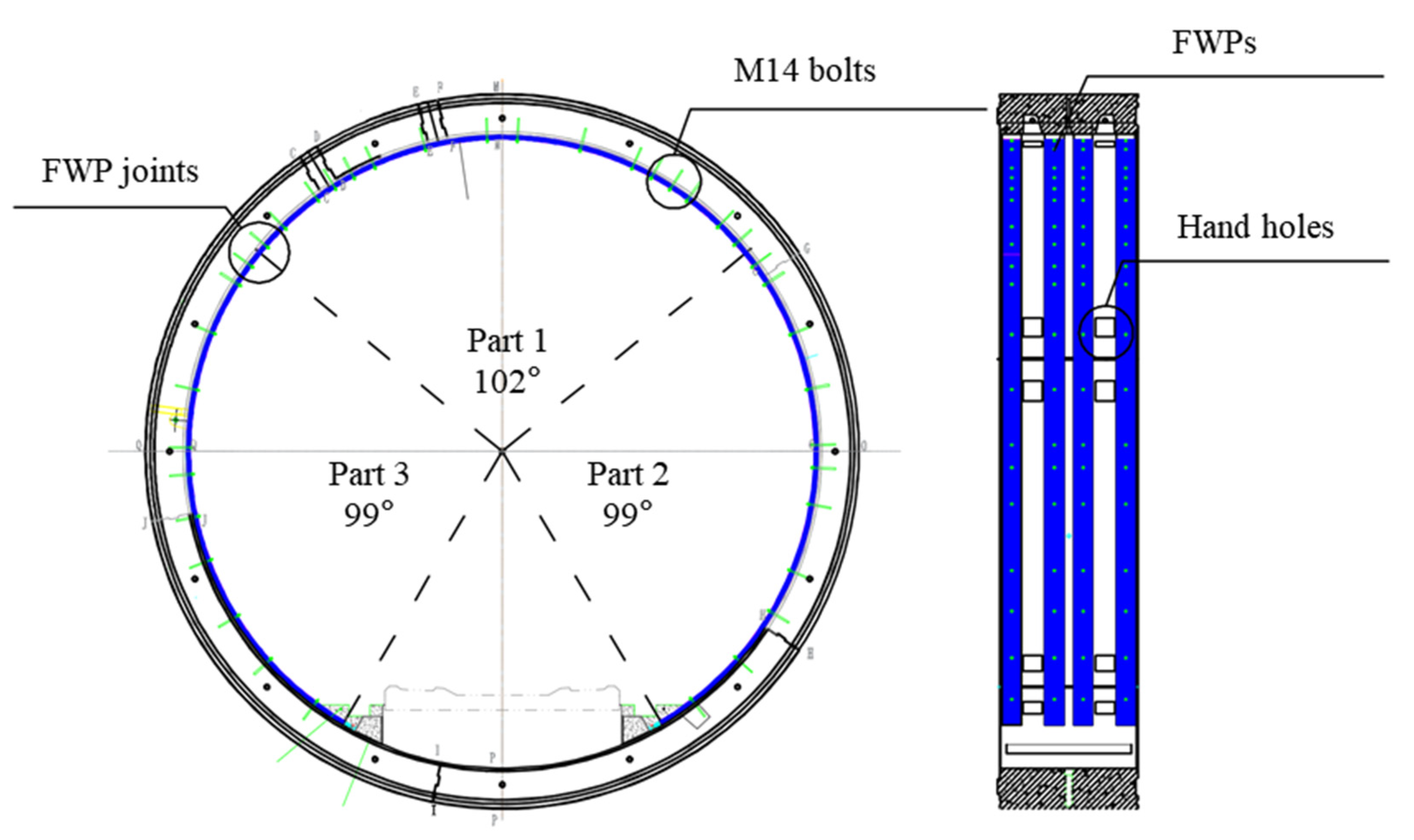

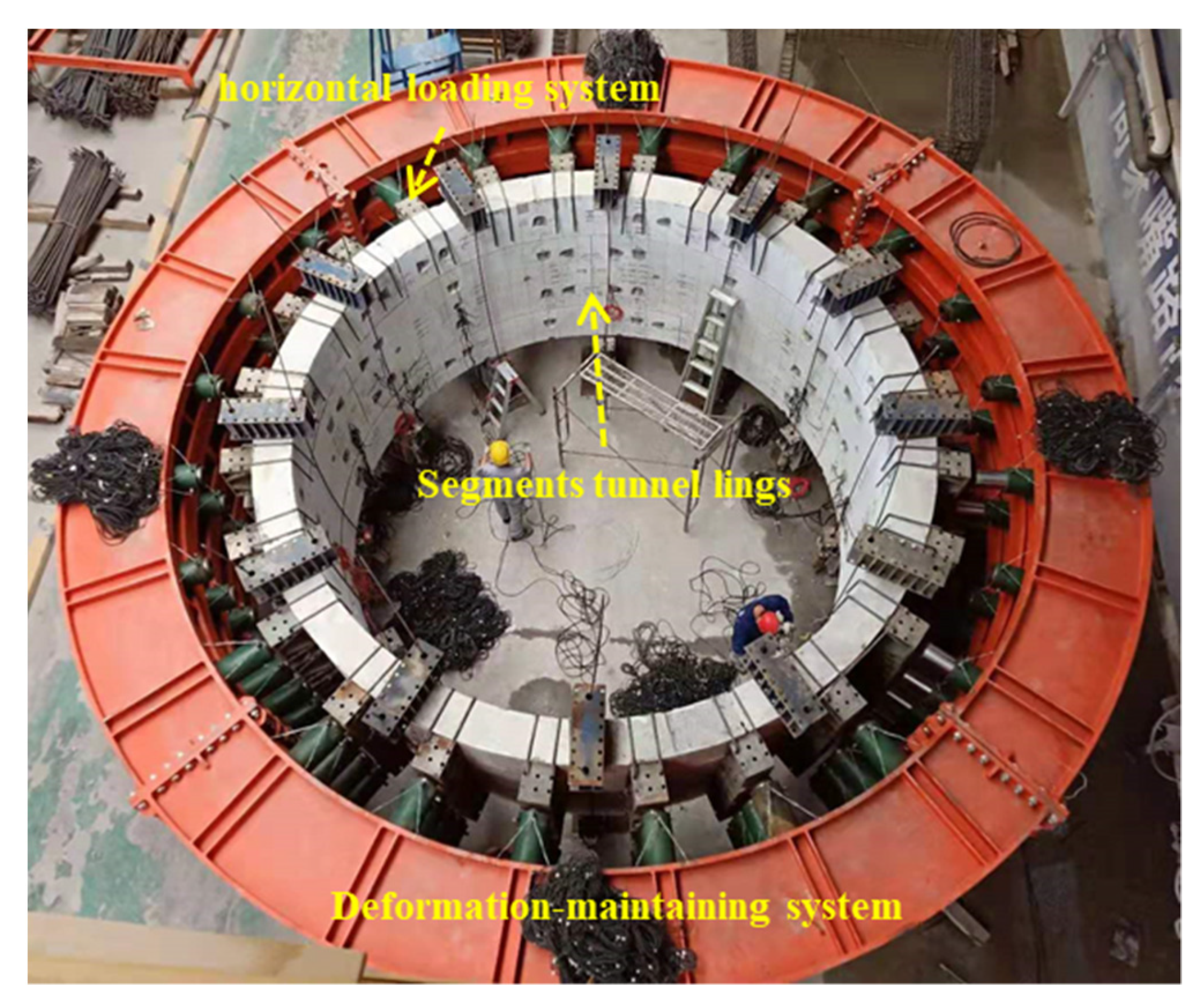
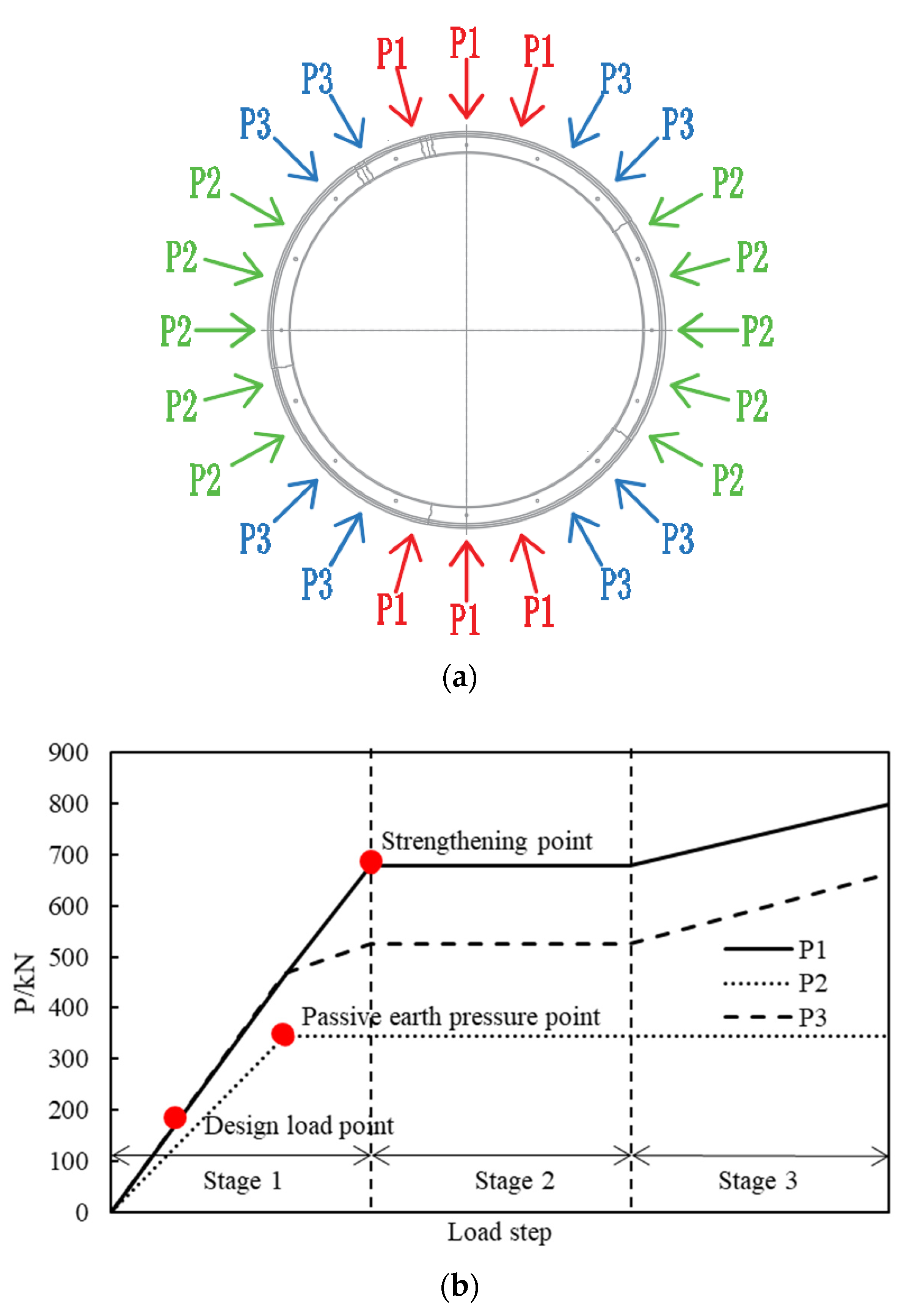
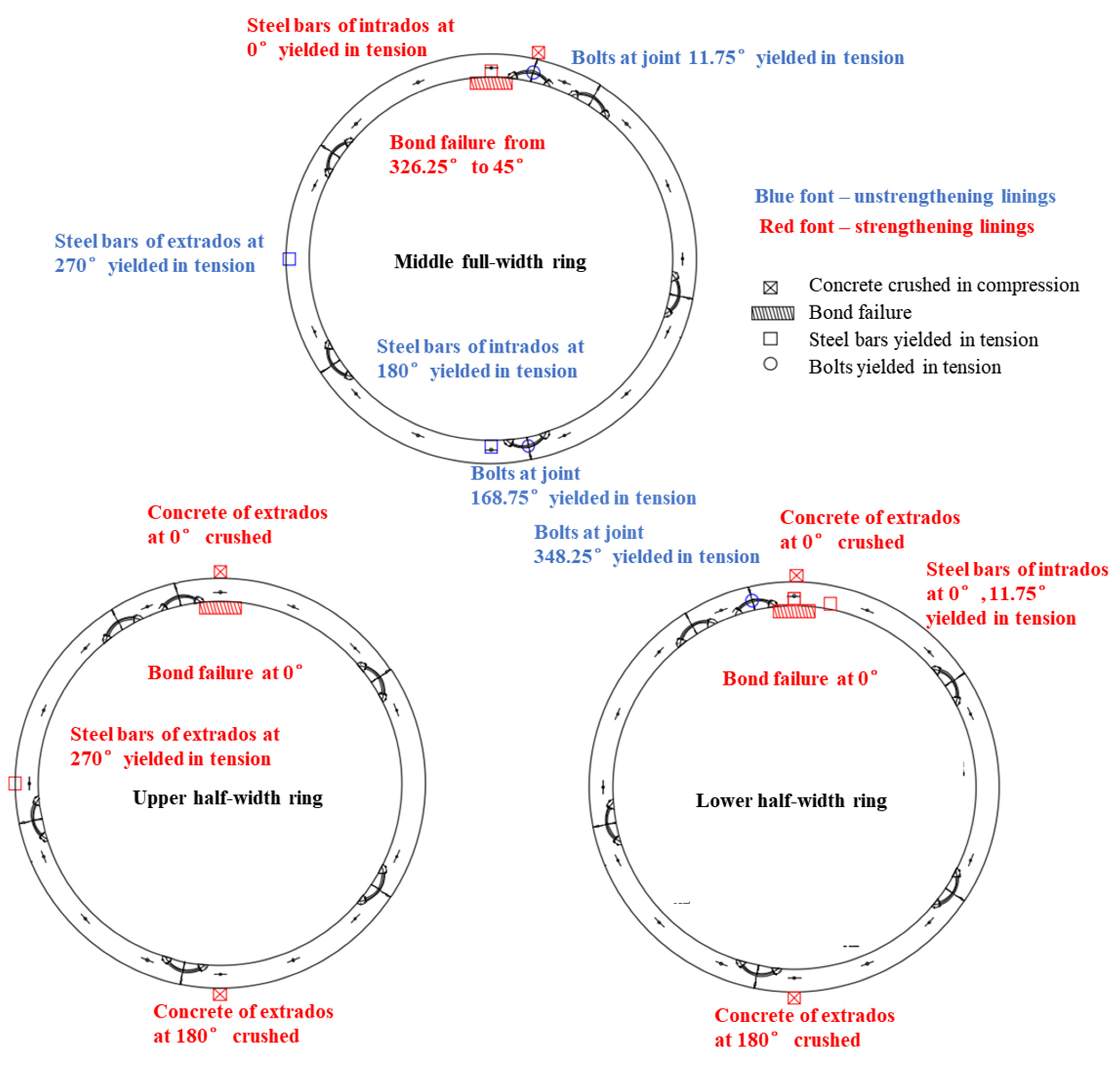
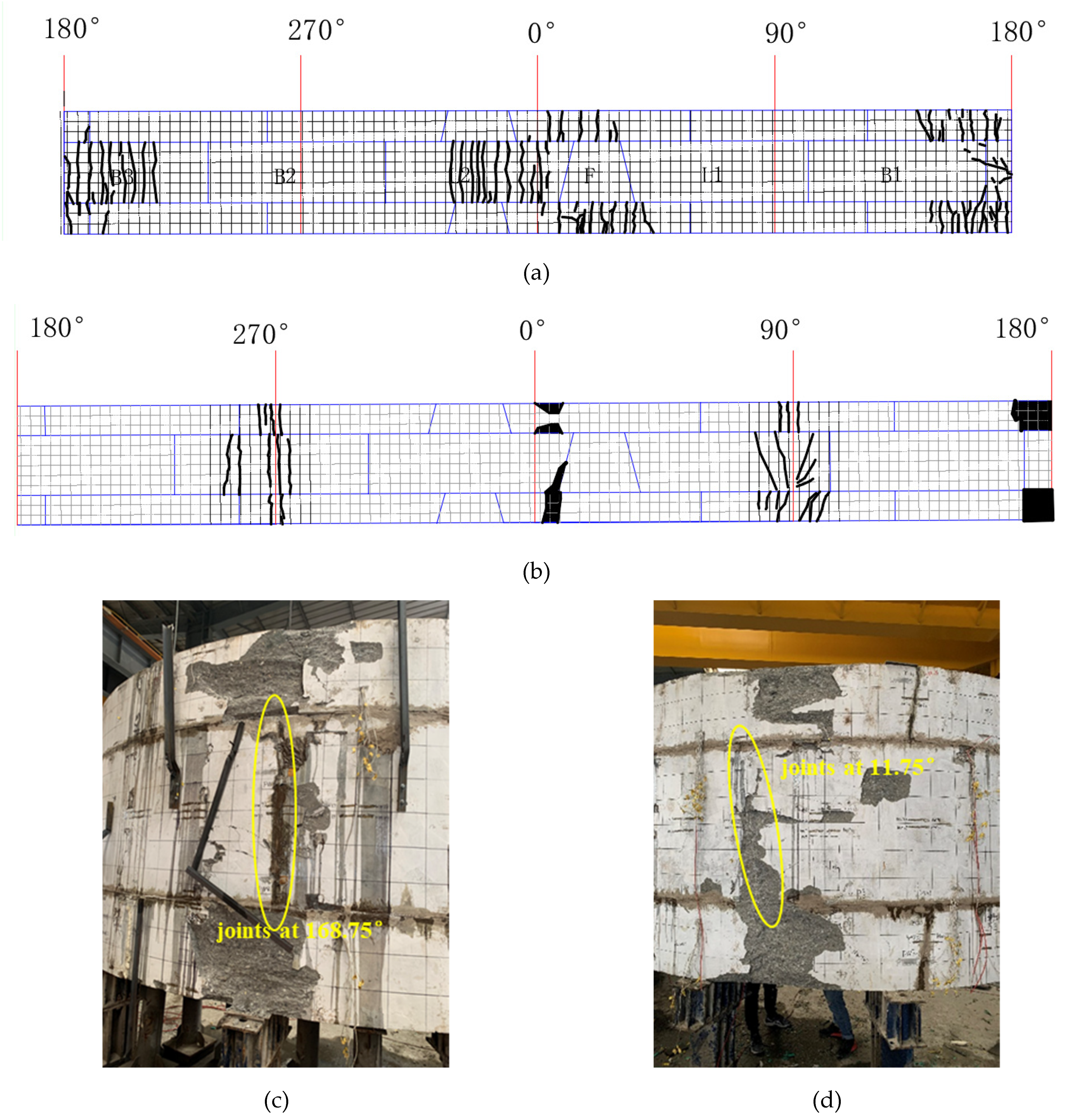
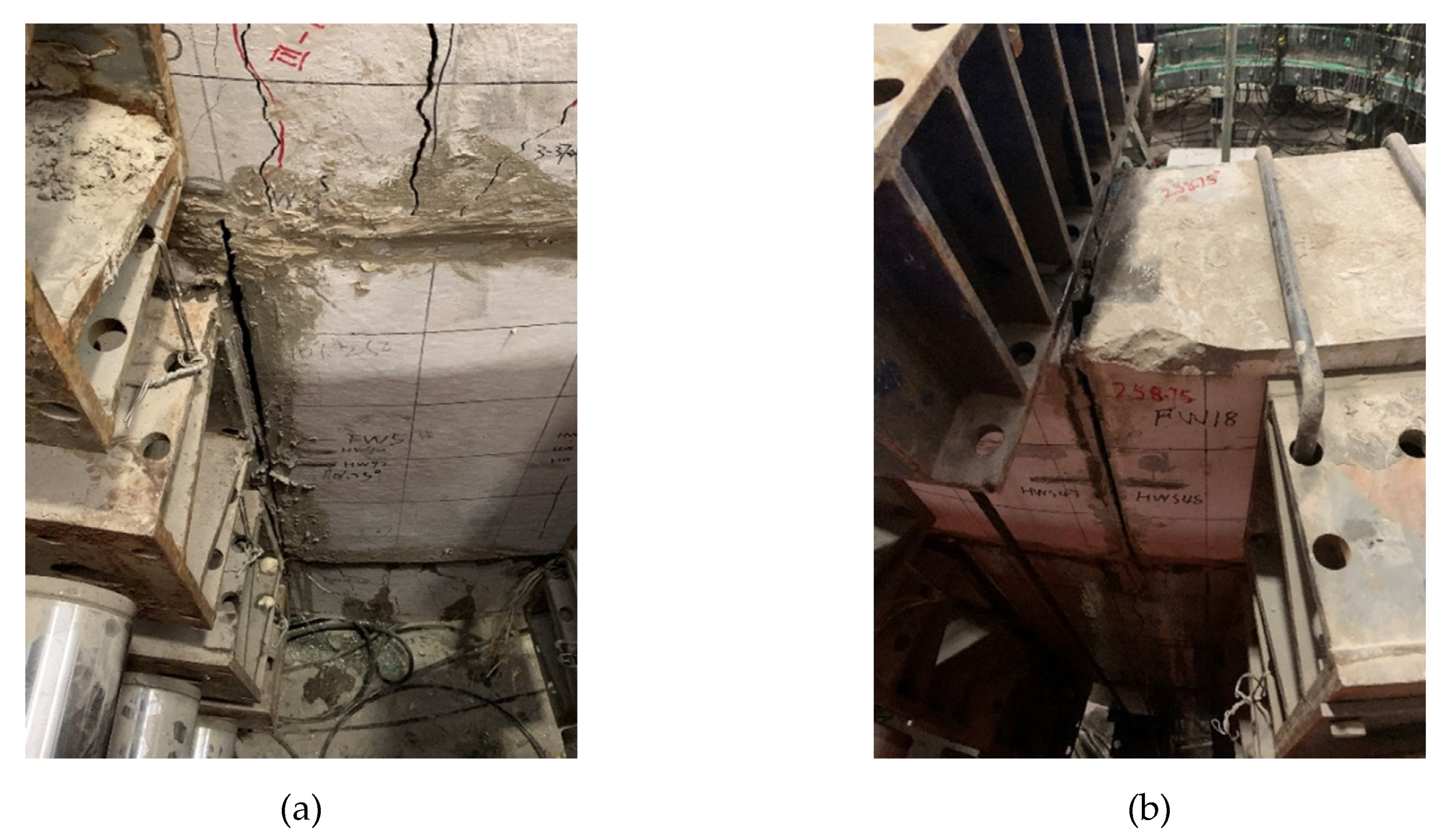
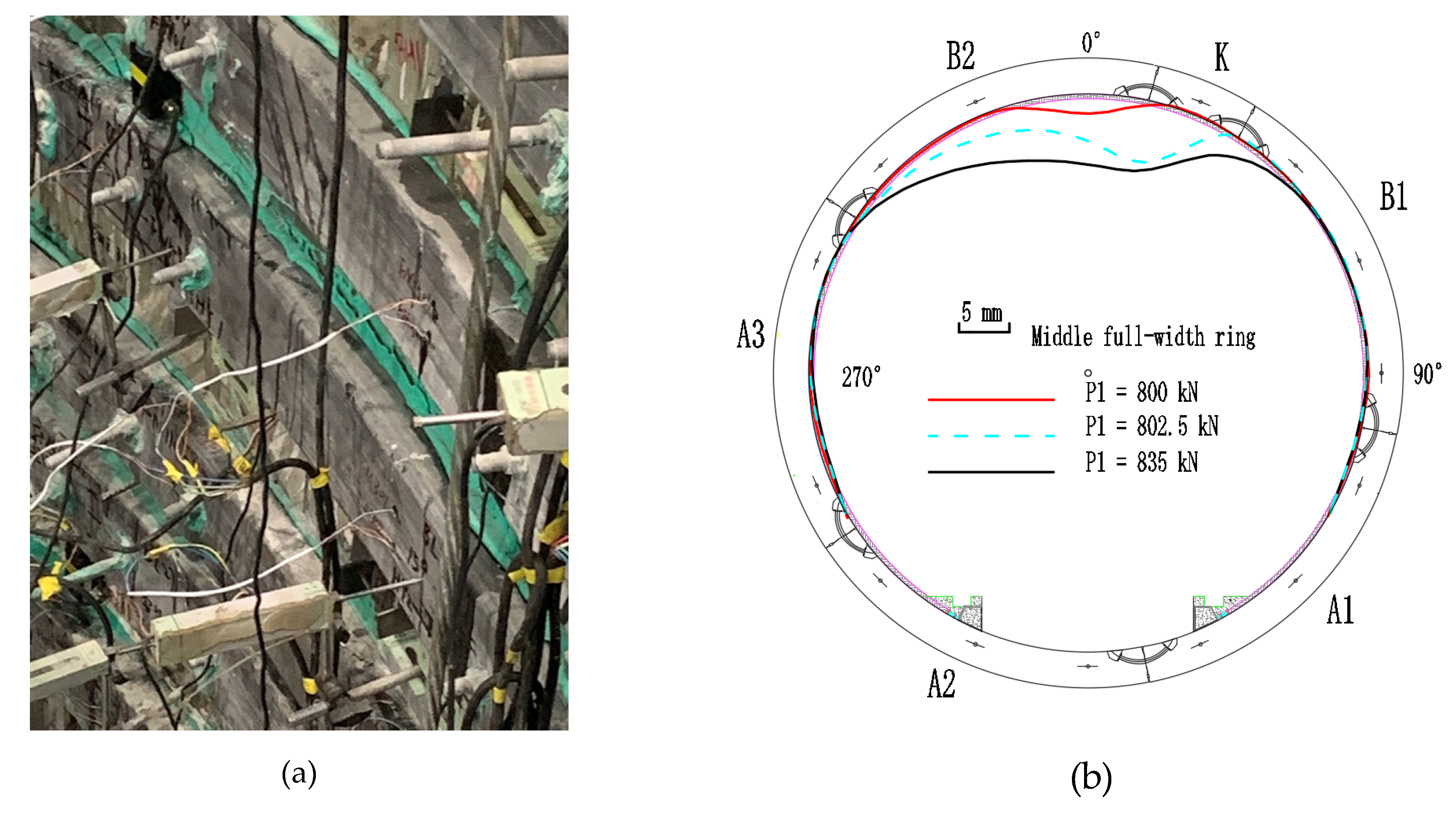
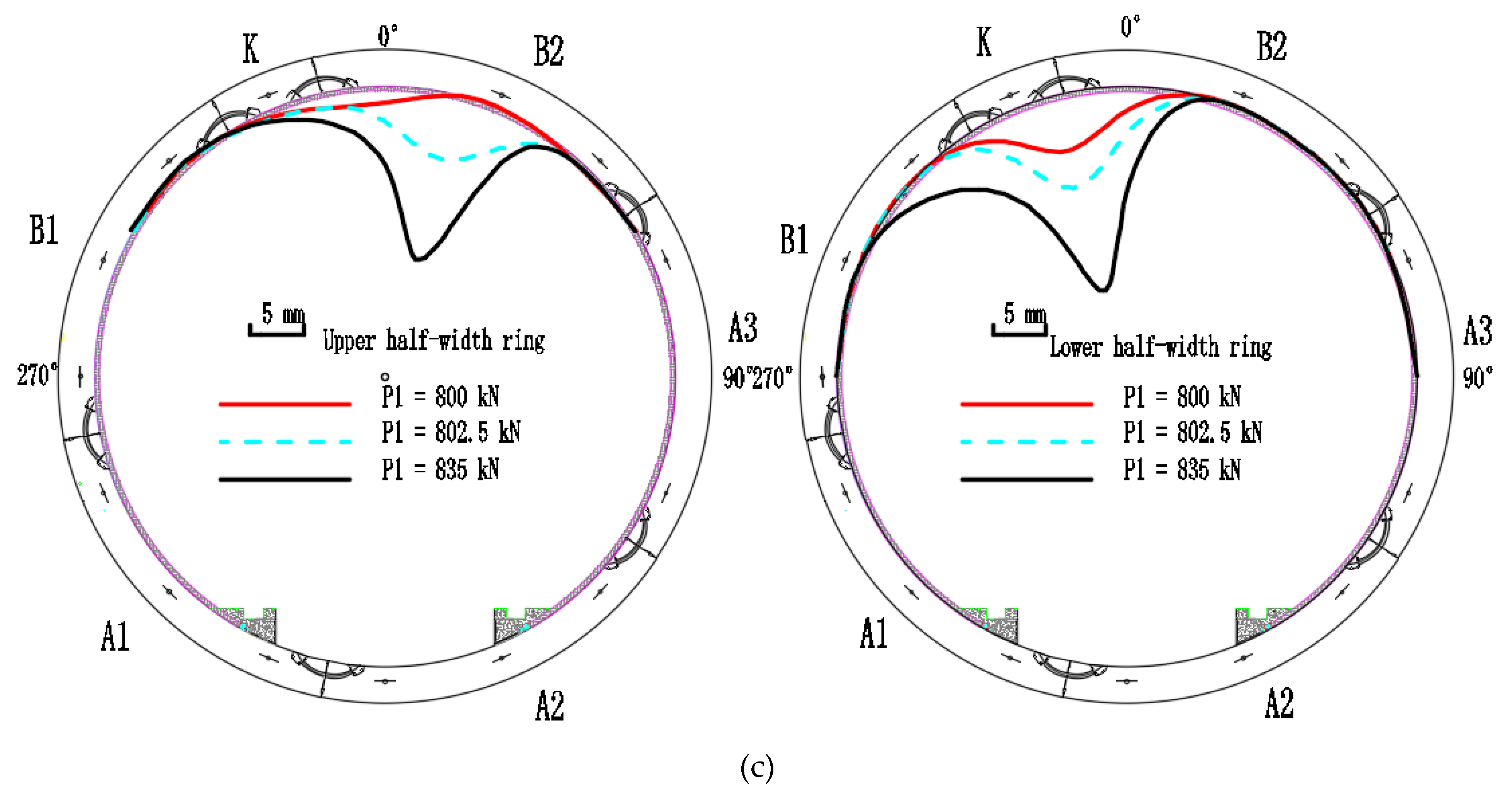
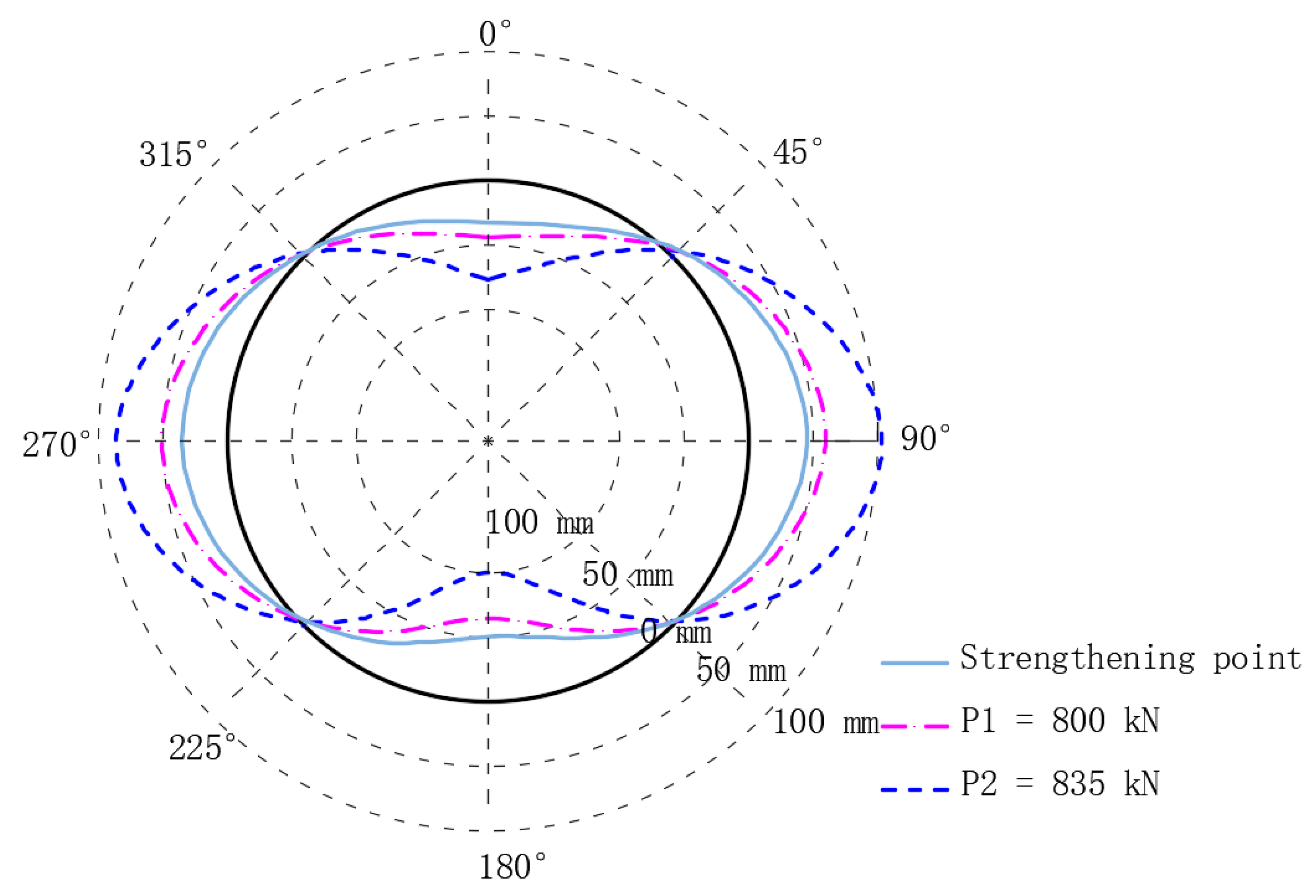
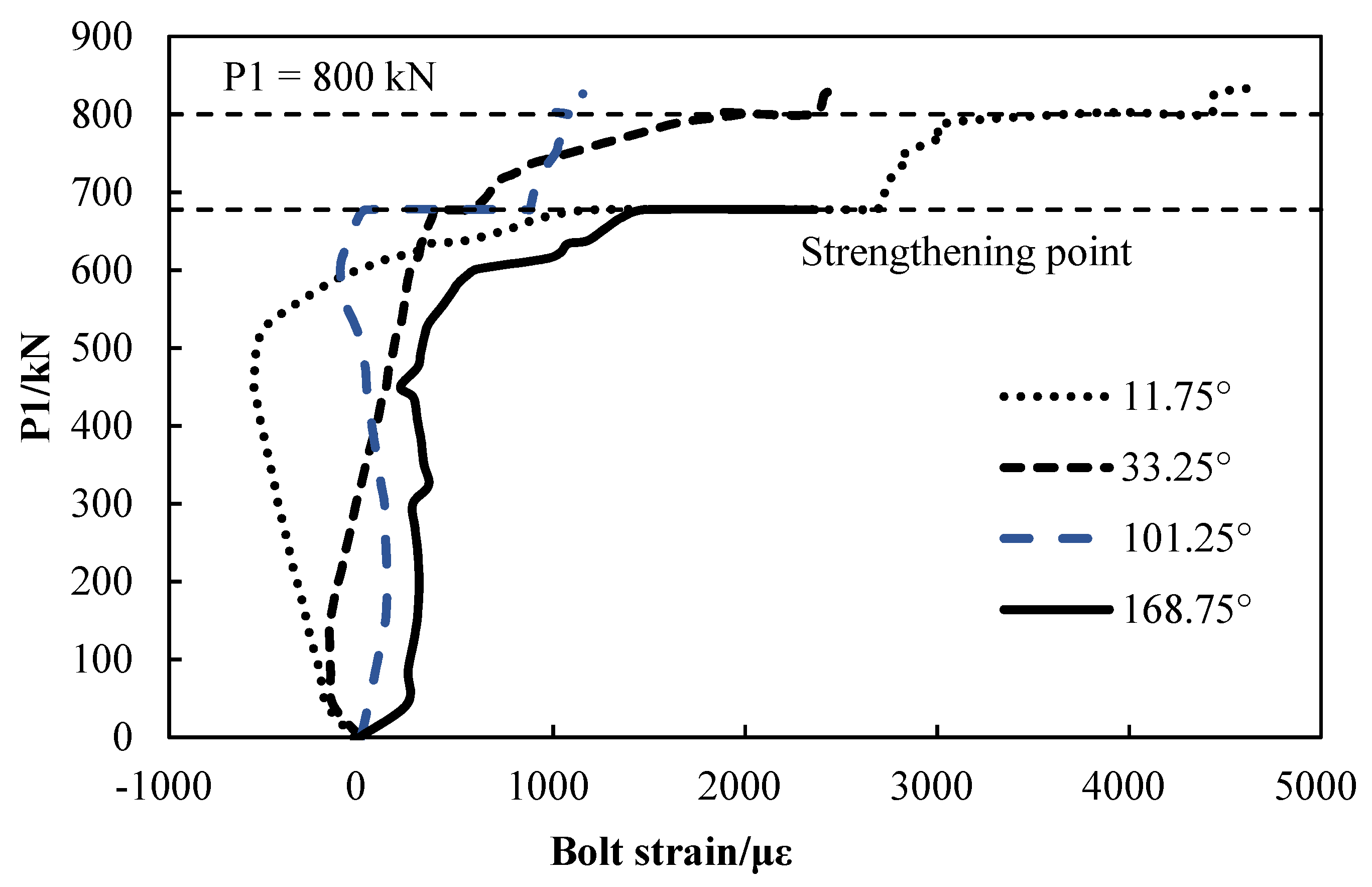
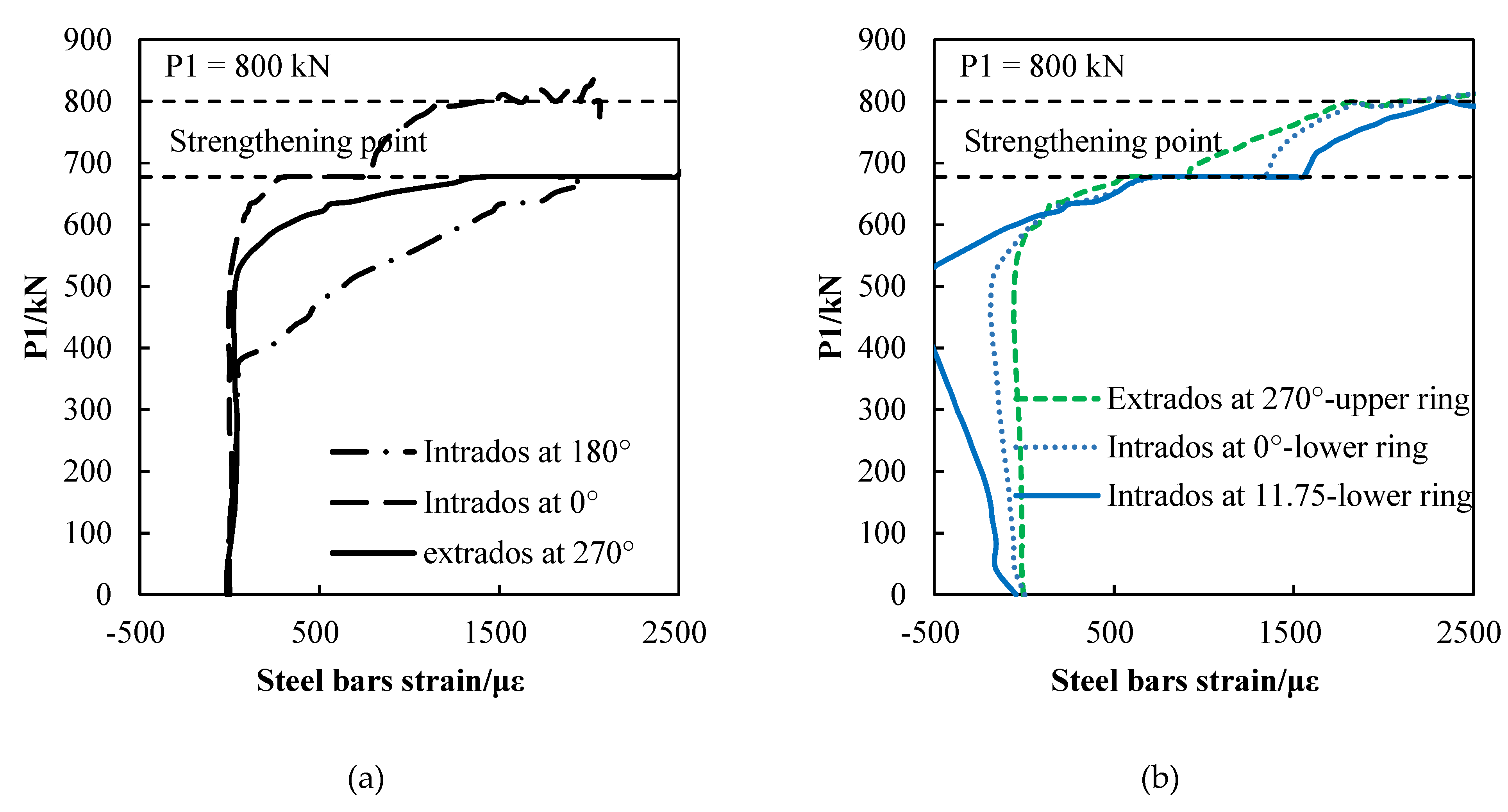

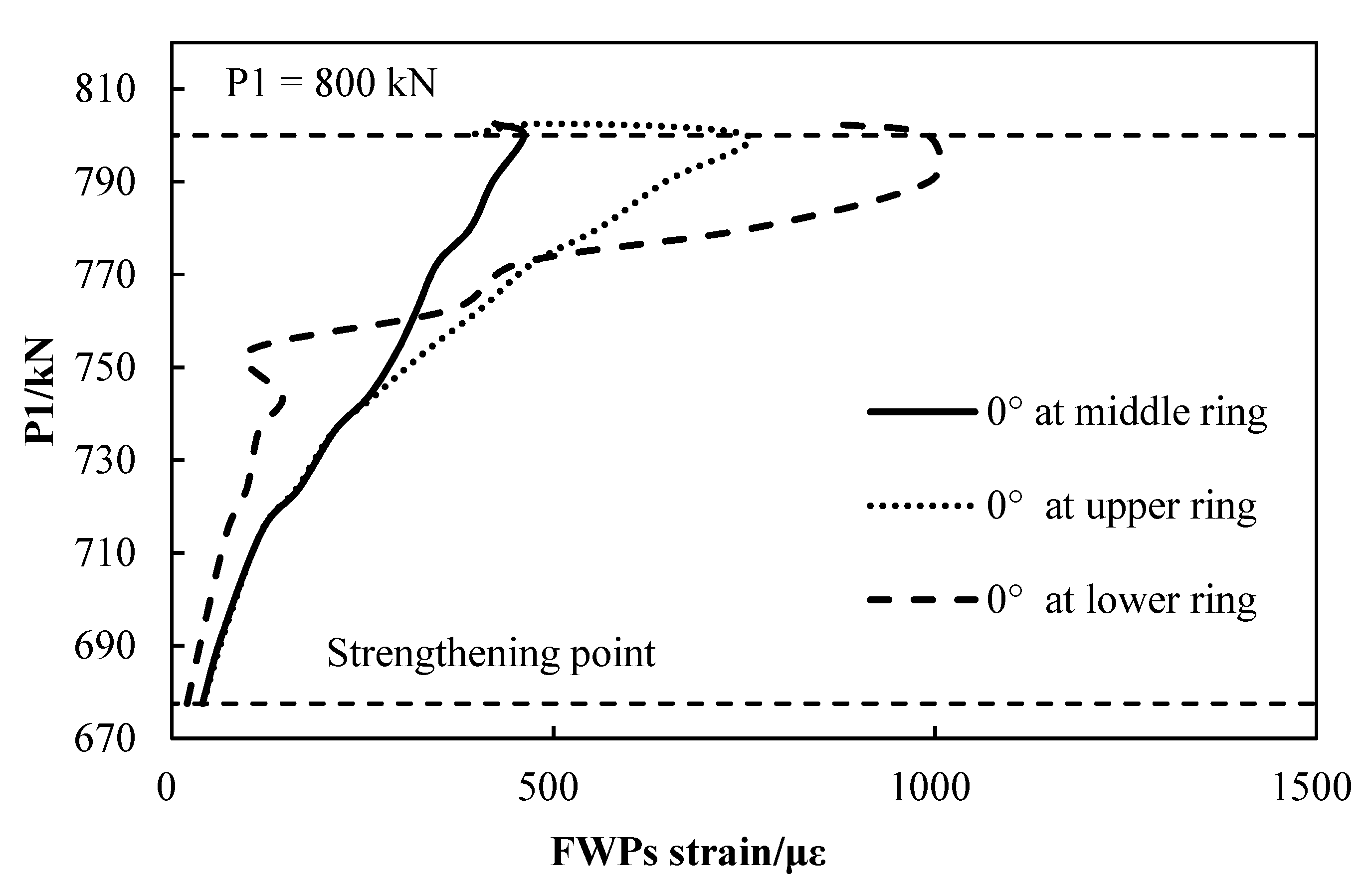
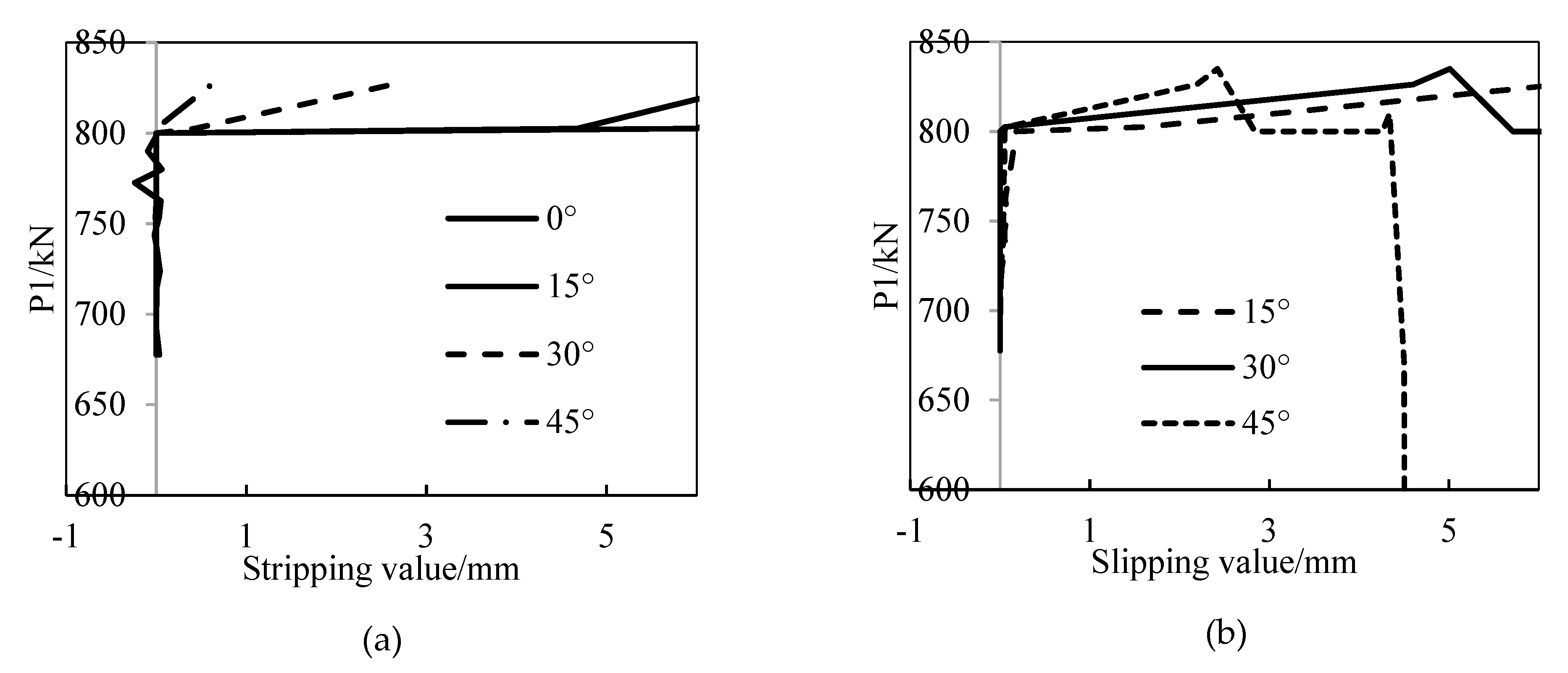
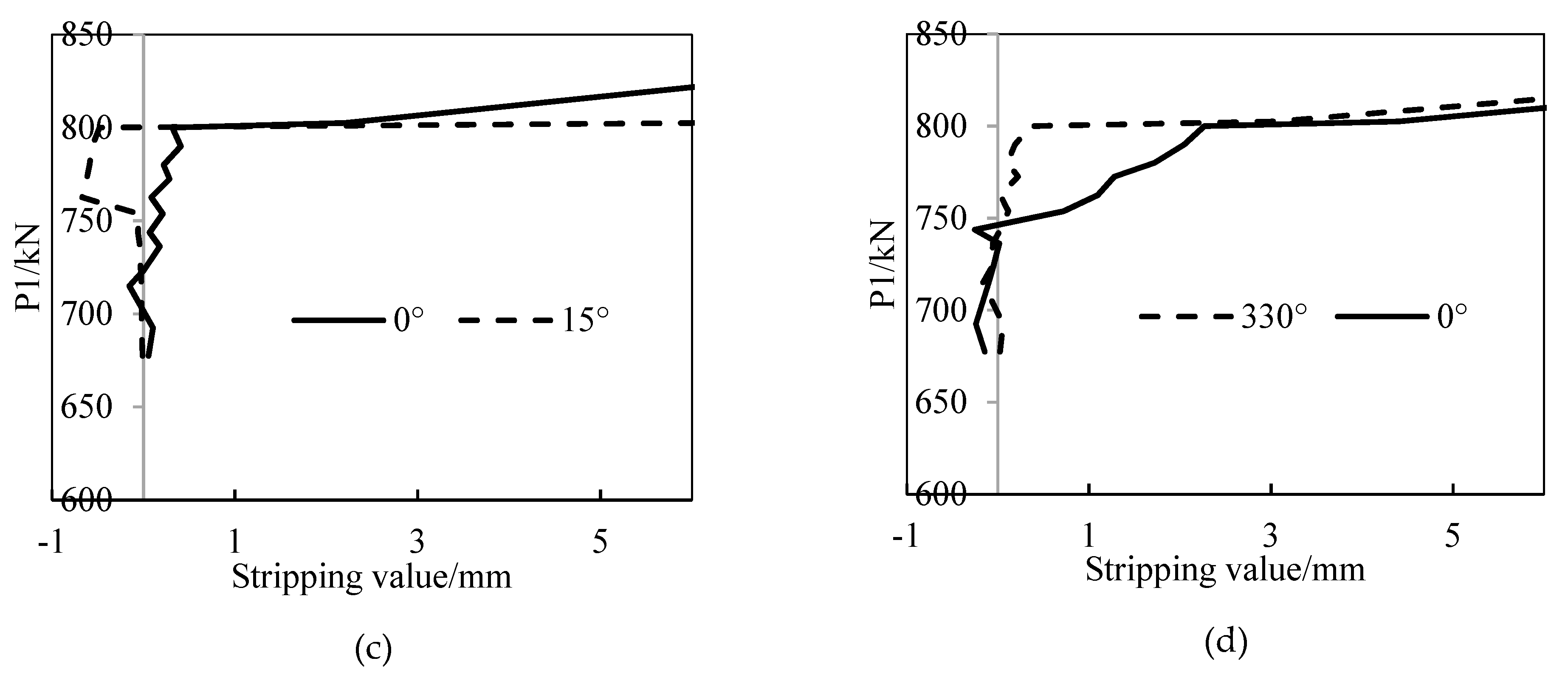
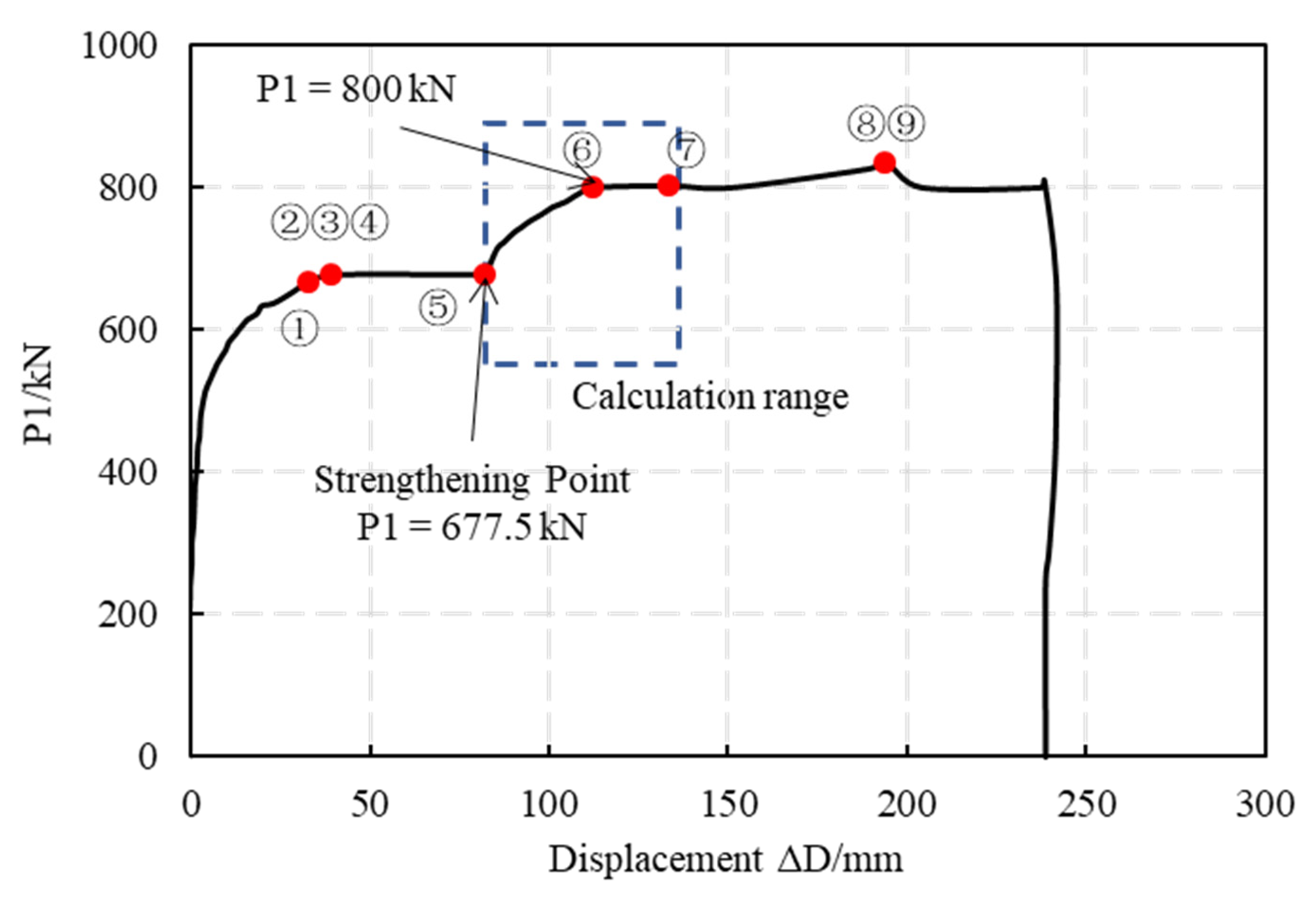

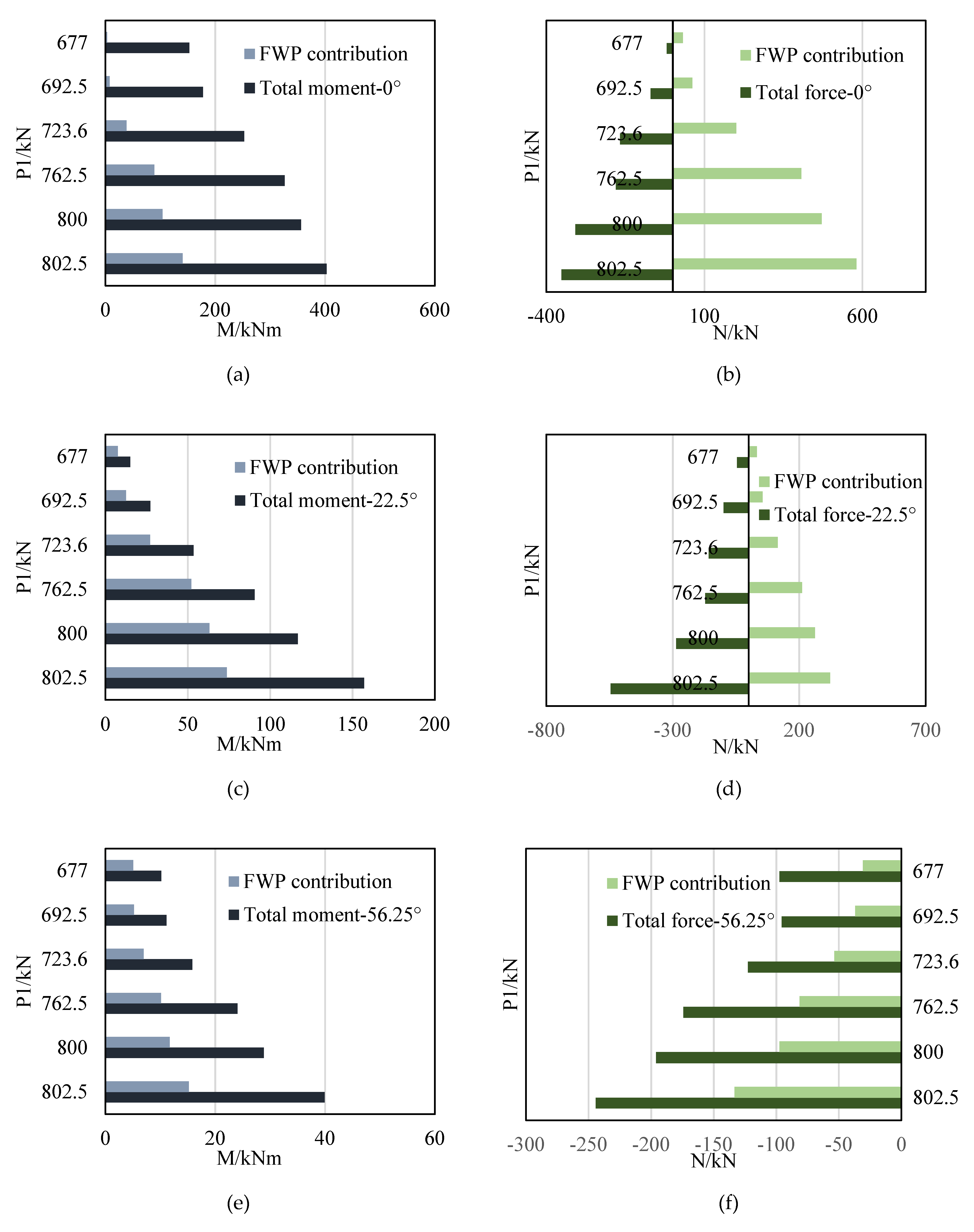
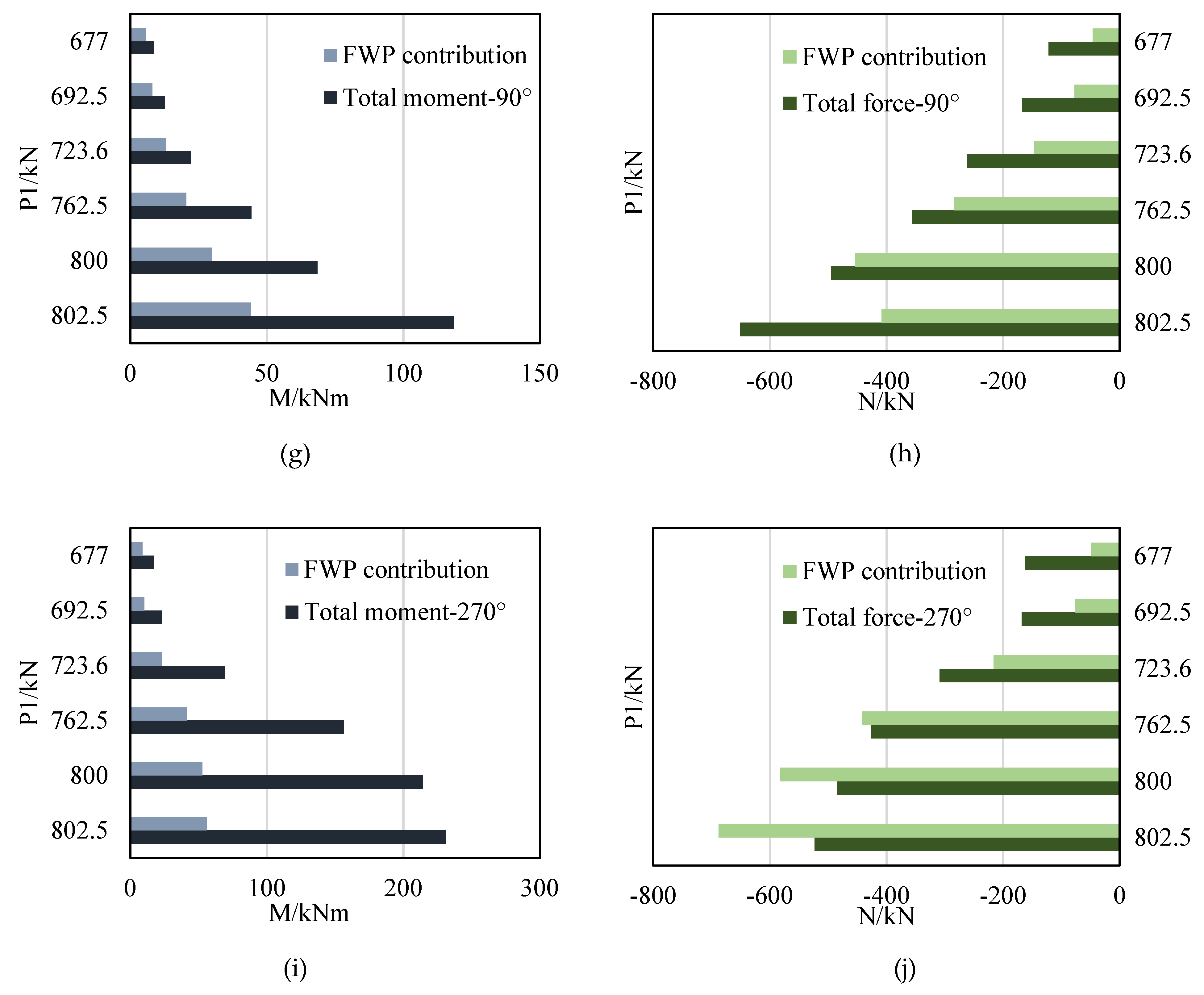
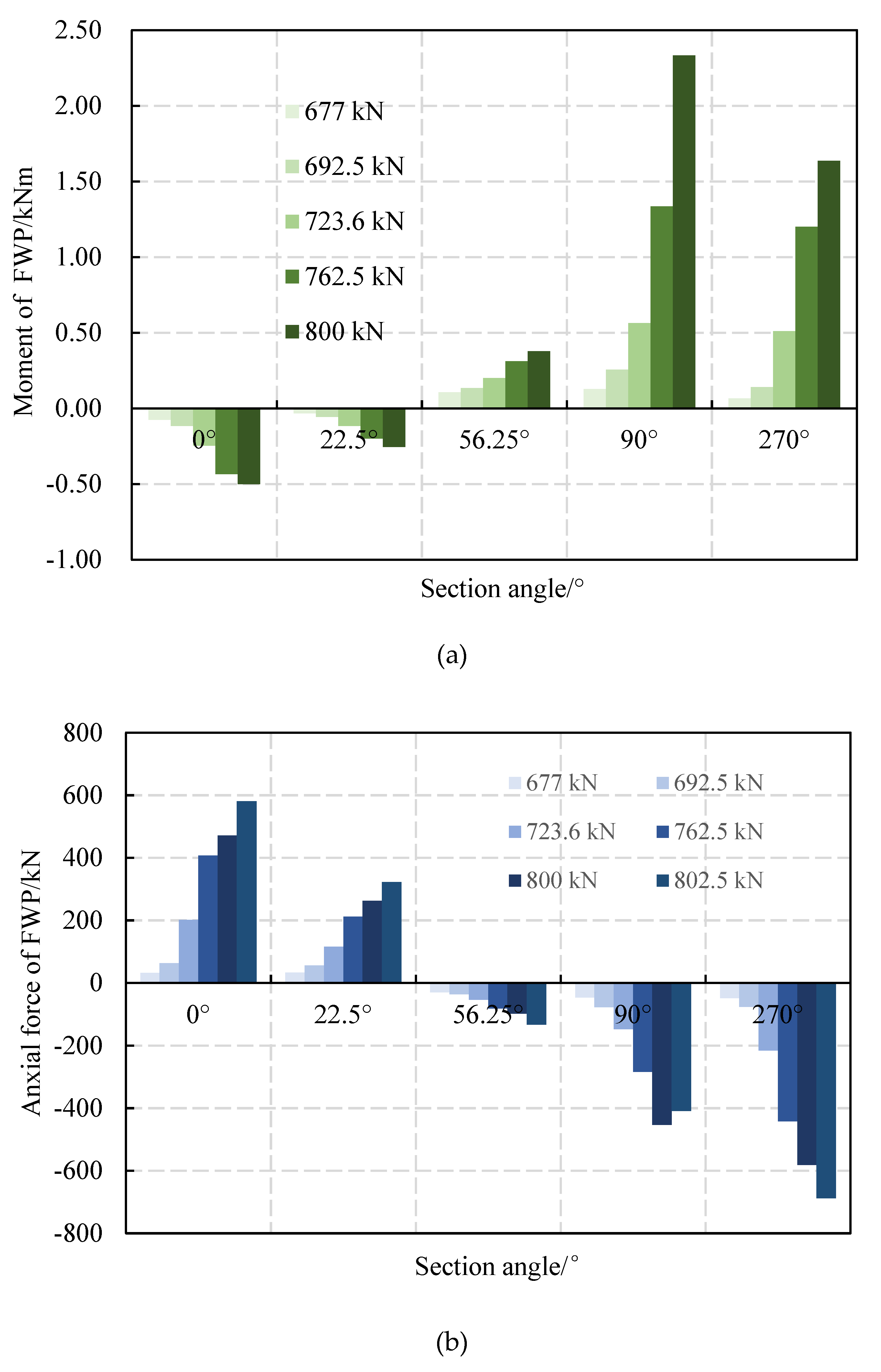

| Test Item | Sensor | Range | Precision | Number |
|---|---|---|---|---|
| Overall deformation | Displacement meter | 500 mm | 0.01 mm | 14 |
| Strain of steel bar | Strain gauge | 20,000 με | 1 με | 416 |
| Strain of bolt | Strain gauge | 20,000 με | 1 με | 48 |
| Strain of concrete | Strain gauge | 20,000 με | 1 με | 308 |
| Joint dilation | Displacement meter | 100 mm | 0.01 mm | 48 |
| Strain of steel FWP | Strain gauge | 20,000 με | 1 με | 308 |
| Relative slippage | Displacement meter | 100 mm | 0.01 mm | 38 |
| Relative stripping value | Displacement meter | 100 mm | 0.01 mm | 38 |
| Incremental Load | Total Load | The Internal Force of 0° | FWP Contribution | The Internal Force of FWP | |||
|---|---|---|---|---|---|---|---|
| /kN | P1/kN | M/kNm | N/kN | M/kNm | N/kN | M/kNm | N/kN |
| 122.5 | 800 | 356.23 | −308.14 | 103.81 | 471.02 | 0.5 | 471.02 |
| Section Angle | N/kN | N/Nu | M/kNm | M/Mu | N/Nu + M/Mu |
|---|---|---|---|---|---|
| 56.25° | −97 | 6.86% | 0.38 | 1.51% | 8.37% |
| 90° | −453 | 32.04% | 2.33 | 9.25% | 41.29% |
| 270° | −581 | 41.09% | 1.64 | 6.51% | 47.60% |
| Load/kN | Displacement/mm | Phenomenon | |
|---|---|---|---|
| ① | 667.5 | 39.73 | the steel bars of intrados at 180° yield because of tension |
| ② | 677.5 | 45.77 | the steel bars of extrados at 270° yield because of tension |
| ③ | the bolts at joint 11.75° of middle full-width ring yield | ||
| ④ | the bolts at joint 168.75° of middle full-width ring yield | ||
| ⑤ | Strengthening point | ||
| ⑥ | 800 | 112.37 | bond failure occurs at 0° |
| ⑦ | 802.5 | 133.79 | the concrete of extrados at 168.75° is crushed in the half-width ring |
| ⑧ | 835 | 194.13 | the concrete of extrados at the 0° is crushed in the half-width ring; the bolts at joint 33.25° of middle full-width ring yield |
| Strengthening Point P1 = 677.5 kN | ΔP1 = 122.5 kN P1 = 800 kN | |||
|---|---|---|---|---|
| Section Angle | M/kNm | N/kN | ΔM/kNm | ΔN/kN |
| 0° | 747.63 | −1773.32 | 356.22 | −308.14 |
| 90° | −755.36 | −1925.76 | −118.49 | −650.44 |
| 180° | 490.75 | −1851.85 | Strain gauge breakdown | |
| 270° | −624.91 | −3536.87 | −214.22 | −484.01 |
| Symbol | Value |
|---|---|
| (kN) | 677.5 |
| (mm) | 82.55 |
| (kN) | 800 |
| (mm) | 112.37 |
| (kN/mm) | 4.11 |
| (kN/mm) | 0.20 |
| (mm) | 29.82 |
| (kN) | 122.50 |
| 18.08% | |
| 20.55 |
Publisher’s Note: MDPI stays neutral with regard to jurisdictional claims in published maps and institutional affiliations. |
© 2022 by the authors. Licensee MDPI, Basel, Switzerland. This article is an open access article distributed under the terms and conditions of the Creative Commons Attribution (CC BY) license (https://creativecommons.org/licenses/by/4.0/).
Share and Cite
Zhang, L.; Liu, X. Experimental Investigation of the Deformed Stagger-Jointed Segmental Tunnel Linings Strengthened by Epoxy-Bonded Filament Wound Profiles. Materials 2022, 15, 6862. https://doi.org/10.3390/ma15196862
Zhang L, Liu X. Experimental Investigation of the Deformed Stagger-Jointed Segmental Tunnel Linings Strengthened by Epoxy-Bonded Filament Wound Profiles. Materials. 2022; 15(19):6862. https://doi.org/10.3390/ma15196862
Chicago/Turabian StyleZhang, Lei, and Xian Liu. 2022. "Experimental Investigation of the Deformed Stagger-Jointed Segmental Tunnel Linings Strengthened by Epoxy-Bonded Filament Wound Profiles" Materials 15, no. 19: 6862. https://doi.org/10.3390/ma15196862
APA StyleZhang, L., & Liu, X. (2022). Experimental Investigation of the Deformed Stagger-Jointed Segmental Tunnel Linings Strengthened by Epoxy-Bonded Filament Wound Profiles. Materials, 15(19), 6862. https://doi.org/10.3390/ma15196862







